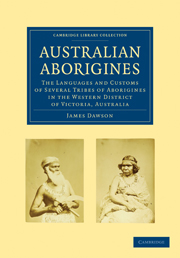 Australian Aborigines
Australian Aborigines Book contents
- Frontmatter
- PREFACE
- INTRODUCTORY NOTE
- Contents
- YARRUUN PARPUR TARNEEN
- CHAPTER I TRIBES
- CHAPTER II POPULATION
- CHAPTER III CHIEFS
- CHAPTER IV PROPERTY
- CHAPTER V CLOTHING
- CHAPTER VI HABITATIONS
- CHAPTER VII CLEANLINESS
- CHAPTER VIII DOMESTIC FURNITURE
- CHAPTER IX COOKING AND FOOD
- CHAPTER X TOOLS
- CHAPTER XI LAWS OF MARRIAGE
- CHAPTER XII CHILDREN
- CHAPTER XIII NAMES OF PERSONS
- CHAPTER XIV SUPERSTITIONS AND DISEASES
- CHAPTER XV DEATH AND BURIAL
- CHAPTER XVI AVENGING OF DEATH
- CHAPTER XVII GREAT MEETINGS
- CHAPTER XVIII AMUSEMENTS
- CHAPTER XIX WEAPONS
- CHAPTER XX ANIMALS
- CHAPTER XXI METEOROLOGY, ASTRONOMY, ETC
- CHAPTER XXII NATIVE MOUNDS
- CHAPTER XXIII ANECDOTES
- CONVEYANCE, BY PRINCIPAL CHIEFS TO JOHN BATMAN, OF 100,000 ACRES OF LAND, BETWEEN GEELONG AND QUEENSCLIFF
- VOCABULARIES.—WORDS; ANIMALS; RELATIONSHIPS; NAMES OF PLACES; GRAMMAR AND SENTENCES; NUMERALS
- NOTES
- Frontmatter
- PREFACE
- INTRODUCTORY NOTE
- Contents
- YARRUUN PARPUR TARNEEN
- CHAPTER I TRIBES
- CHAPTER II POPULATION
- CHAPTER III CHIEFS
- CHAPTER IV PROPERTY
- CHAPTER V CLOTHING
- CHAPTER VI HABITATIONS
- CHAPTER VII CLEANLINESS
- CHAPTER VIII DOMESTIC FURNITURE
- CHAPTER IX COOKING AND FOOD
- CHAPTER X TOOLS
- CHAPTER XI LAWS OF MARRIAGE
- CHAPTER XII CHILDREN
- CHAPTER XIII NAMES OF PERSONS
- CHAPTER XIV SUPERSTITIONS AND DISEASES
- CHAPTER XV DEATH AND BURIAL
- CHAPTER XVI AVENGING OF DEATH
- CHAPTER XVII GREAT MEETINGS
- CHAPTER XVIII AMUSEMENTS
- CHAPTER XIX WEAPONS
- CHAPTER XX ANIMALS
- CHAPTER XXI METEOROLOGY, ASTRONOMY, ETC
- CHAPTER XXII NATIVE MOUNDS
- CHAPTER XXIII ANECDOTES
- CONVEYANCE, BY PRINCIPAL CHIEFS TO JOHN BATMAN, OF 100,000 ACRES OF LAND, BETWEEN GEELONG AND QUEENSCLIFF
- VOCABULARIES.—WORDS; ANIMALS; RELATIONSHIPS; NAMES OF PLACES; GRAMMAR AND SENTENCES; NUMERALS
- NOTES
Summary
The country belonging to a tribe is generally distinguished by the name or language of that tribe. The names of tribes are taken from some local object, or from some peculiarity in the country where they live, or in their pronunciation; and when an individual is referred to, ‘Kuurndit’—meaning ‘member of’—is affixed to the tribal name, in the same way as the syllable ‘er’ is added to London, ‘Londoner,’ or ‘ite’ to Melbourne, ‘Melbournite.’ Thus the Mount Rouse tribe is called ‘Kolor,’ after the aboriginal name of the mountain; and a member of the tribe is called ‘Kolor kuurndit.’ The language of the Kolor tribe is called ‘Chaap wuurong,’ meaning ‘soft’ or ‘broad lip,’ in contradistinction to other dialects of harder pronunciation. The Kolor tribe and its language occupy the country commencing near Mount Napier, thence to German-town, Dunkeld, Wickliffe, Lake Boloke, down the Salt Creek to Hexham, to Caramut, and to starting point.
The Kuurn kopan noot tribe is known by the name of its language, ‘Kuurn kopan noot,’ meaning ‘small lip,’ or ‘short pronunciation,’ with ‘Kuurndit’ affixed for an individual of the tribe, who is called ‘Kuurn kopan noot kuurndit.’ Its territory, commencing in the middle of the Tarrone swamp, ‘Yaluuk,’ extends to Dunmore House dam, Upper Moyne Falls, Buunbatt, Goodwood main cattle camp, Marramok swamp, and round by South Green Hills station to starting point.
- Type
- Chapter
- Information
- Australian AboriginesThe Languages and Customs of Several Tribes of Aborigines in the Western District of Victoria, Australia, pp. 1 - 2Publisher: Cambridge University PressPrint publication year: 2009First published in: 1881


